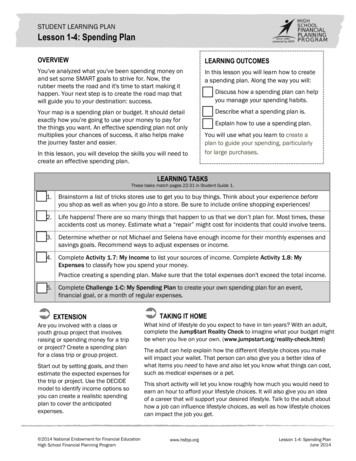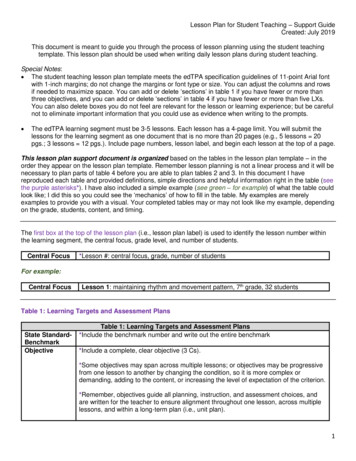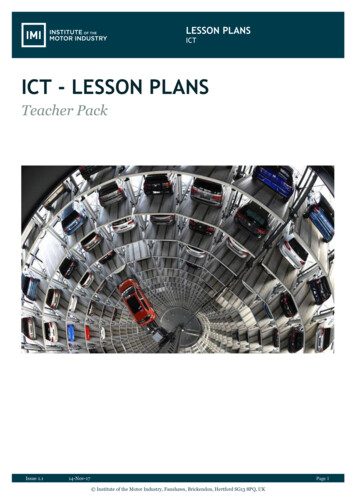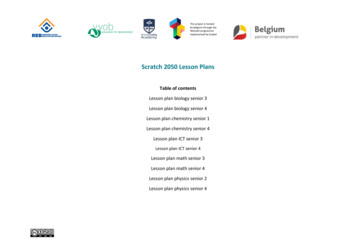
Transcription
STUDENT LEARNING PLANLesson 1-4: Spending PlanOVERVIEWLEARNING OUTCOMESYou've analyzed what you've been spending money onand set some SMART goals to strive for. Now, therubber meets the road and it's time to start making ithappen. Your next step is to create the road map thatwill guide you to your destination: success.In this lesson you will learn how to createa spending plan. Along the way you will:Your map is a spending plan or budget. It should detailexactly how you're going to use your money to pay forthe things you want. An effective spending plan not onlymultiplies your chances of success, it also helps makethe journey faster and easier. Describe what a spending plan is.In this lesson, you will develop the skills you will need tocreate an effective spending plan. Discuss how a spending plan can helpyou manage your spending habits. Explain how to use a spending plan.You will use what you learn to create aplan to guide your spending, particularlyfor large purchases.LEARNING TASKSThese tasks match pages 22-31 in Student Guide 1.1.Brainstorm a list of tricks stores use to get you to buy things. Think about your experience beforeyou shop as well as when you go into a store. Be sure to include online shopping experiences!2.Life happens! There are so many things that happen to us that we don’t plan for. Most times, theseaccidents cost us money. Estimate what a “repair” might cost for incidents that could involve teens.3.Determine whether or not Michael and Selena have enough income for their monthly expenses andsavings goals. Recommend ways to adjust expenses or income.4.Complete Activity 1.7: My Income to list your sources of income. Complete Activity 1.8: MyExpenses to classify how you spend your money.Practice creating a spending plan. Make sure that the total expenses don't exceed the total income.5.Complete Challenge 1-C: My Spending Plan to create your own spending plan for an event,financial goal, or a month of regular expenses. EXTENSIONAre you involved with a class oryouth group project that involvesraising or spending money for a tripor project? Create a spending planfor a class trip or group project.Start out by setting goals, and thenestimate the expected expenses forthe trip or project. Use the DECIDEmodel to identify income options soyou can create a realistic spendingplan to cover the anticipatedexpenses. 2014 National Endowment for Financial EducationHigh School Financial Planning Program TAKING IT HOMEWhat kind of lifestyle do you expect to have in ten years? With an adult,complete the Jump tart Reality Check to imagine what your budget mightbe when you live on your own. (www.jumpstart.org/reality-check.html)The adult can help explain how the different lifestyle choices you makewill impact your wallet. That person can also give you a better idea ofwhat items you need to have and also let you know what things can cost,such as medical expenses or a pet.This short activity will let you know roughly how much you would need toearn an hour to afford your lifestyle choices. It will also give you an ideaof a career that will support your desired lifestyle. Talk to the adult abouthow a job can influence lifestyle choices, as well as how lifestyle choicescan impact the job you get.www.hsfpp.orgLesson 1-4: Spending PlanJune 2014
Activity 1.7: My IncomeNAME:DATE:1. What kinds of income do you normally receive throughout the year?2. Are there certain times when you seem to earn more money than usual?3. What are some predictions you can make about your income this year based on what you’veearned before? 2014 National Endowment for Financial EducationHigh School Financial Planning Programwww.hsfpp.orgActivity 1.7: My IncomeJune 2014
Activity 1.8: My ExpensesNAME:DATE:Directions:Use your spending log from Activity 1.2 My Disappearing Dollars to group your expenses intocategories. Calculate what percent of your total spending is used for each category.PercentExpense Type%%%%%%%%100% 2014 National Endowment for Financial EducationHigh School Financial Planning Programwww.hsfpp.orgActivity 1.8: My ExpensesJune 2014
Task: Maya’s Spending PlanNAME:DATE:Scenario:Maya is a senior in high school. She earns 8 an hour working approximately 25 hours a week at thelocal grocery store. An estimated 30 percent of her pay is deducted for taxes. Maya also earnsapproximately 15 each month in interest on savings.Maya still owes money on her used car ( 235 a month), but she doesn’t pay rent because she liveswith her parents. She is responsible for the following expenses every month: cellphone ( 35– 45),gas ( 40– 60), and auto insurance ( 50). Maya likes to play video games and listen to music, soshe frequently buys games and music. Maya typically buys her own clothes and electronic gadgets,but she also receives gifts from her family for special occasions.One of Maya’s short-term goals is to take a trip to visit her grandparents right after graduation. Sheexpects this to cost 1,000, and she has already saved 500. A long-term goal is to attend collegeover the next four to five years at the local state school. She plans to pay part of the tuition from hersavings and will need to find other funding sources. So far she has set aside 7,000 for her collegefund.Directions:Create a monthly spending plan for Maya using the information provided. Use this Spending Planworksheet to build the plan. (Option: Download the spreadsheet file from www.hsfpp.org to easilyadjust the income and expense amounts.) 2014 National Endowment for Financial EducationHigh School Financial Planning Programwww.hsfpp.orgTask: Maya’s Spending PlanJune 2014
Task: Maya’s Spending PlanStep 1: List Maya’s anticipatedMaya’s Monthly Income:Amountsmonthly income sources andamounts. Calculate the totalincome she expects to receiveMaya’s Total Income:in a month.Step 2: Add expense categoriesMaya’s Monthly Expenses and PYF:Amountsand insert predicted amounts foreach category. Remember toinclude “pay yourself first”amounts to build up Maya’s tripfund and college fund. Calculatethe predicted total amountneeded to cover expenses andsavings goals.Maya’s Total Expenses:Step 3: Compare the totalincome to total expenses. Makeadjustments to the expenseTotal Income:Total Expenses:Difference:amounts to ensure that Maya cancover the expenses with theincome she expects each month. 2014 National Endowment for Financial EducationHigh School Financial Planning Programwww.hsfpp.orgTask: Maya’s Spending PlanJune 2014
Challenge 1-C: My Spending PlanNAME:DATE:For this challenge task, create a spending plan to guide your spending for the next several weeks or thenext month, or create a plan for a specific large purchase. Add this plan to your personal financialplanning portfolio to use as a model whenever your future circumstances change.Directions:Do you have to pay for a major purchase, save money for an upcoming event such as a class trip, or takeresponsibility for regular expenses every month? Apply what you have learned about spending plans asyou complete this challenge to plan for your spending responsibility. 1. Preview the criteria listed in the Scoring Guide to plan for your assessment. 4. Self-assess your work using the Scoring Guide. Optional: Ask a classmate or family member topeer assess your work using the Scoring Guide to evaluate your work.2. Review your financial goals and spending log.3. Write up a spending plan so you can pay for the things or events you need and want. Use the formbelow or create your own spreadsheet.Purpose of My Spending Plan:My Income:AmountsMy Total Income: My Expenses:AmountsMy Total Expenses: 2014 National Endowment for Financial EducationHigh School Financial Planning Program www.hsfpp.orgChallenge 1-C: My Spending PlanJune 2014
Challenge 1-C: My Spending PlanNAME:DATE:Required CriteriaStatusContent1.In one sentence you state what you want to achieve as a result of thespending plan.acceptablenot acceptable2.Outcome involves a specific situation such as a major purchase goal or aspecific time period (month or semester).acceptablenot acceptable3.You justify how the spending plan is relevant to existing circumstancesand values (or a mock situation).acceptablenot acceptable4. Income amounts can be expected and do NOT include “chance” income.acceptablenot acceptable5. Each income category is labeled to identify the source or type.acceptablenot acceptable6. Each expense category is labeled to identify the type.acceptablenot acceptable7. Spending Plan contains a Pay Yourself First (PYF) element.acceptablenot acceptable8. Evidence is provided to verify the anticipated expense amounts.acceptablenot acceptable9. Total expenses do NOT exceed total income.acceptablenot acceptable10.You state how the Spending Plan can be adjusted after the Plan isdeployed if total expenses turn out to be more than anticipated.acceptablenot acceptable11.You state how the Spending Plan can be adjusted after the Plan isdeployed if actual income turns out to be more than anticipated.acceptablenot acceptable12. Spending Plan includes a label with title and date range.acceptablenot acceptable13. Documentation is neat and easy to read.acceptablenot acceptable14. Calculations are accurate.acceptablenot acceptableGeneralFeedback: 2014 National Endowment for Financial EducationHigh School Financial Planning ProgramScore: /www.hsfpp.orgChallenge 1-C: My Spending PlanJune 2014
High School Financial Planning Program www.hsfpp.org Lesson 1-4: Spending Plan June 2014 STUDENT LEARNING PLAN . Lesson 1-4: Spending Plan . OVERVIEW You've analyzed what you've been spending money on and set some SMART goals to strive for. Now, the rubber meets the road and it's time to start making it










